Feb
19
2010
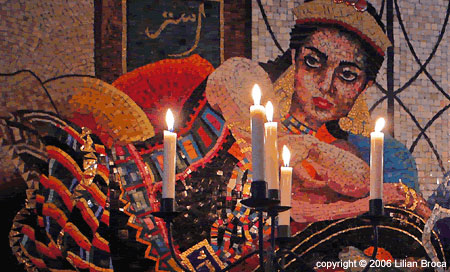
or Smells Like Holy Spirit
A friend recently gave me a unique gift. With some difficulty and great expense, he sourced the ingredients for the anointing oil of the Aaronic priesthood and I was the grateful recipient of a small, blue vial.
The scent of the oil is intoxicating. You breathe it in and in some strange way you can “taste” it as it goes down. It is extremely complex and yet a single fragrance. Continue reading
Comments Off | tags: Ark of the Covenant, Atonement, Covenant Theology, Creation Week, David, Esther, Ezekiel, Genesis, Greater Eve, Incense Altar, James Jordan, Peter Leithart, Resurrection, Saul, Tabernacle | posted in Biblical Theology, Quotes, The Last Days, The Restoration Era
Feb
4
2010
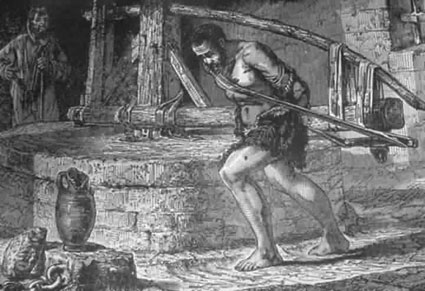
On Day 3 we have grain and fruit plants. They are the promise of bread and wine at God’s Sabbath table on Day 7.
The third elected judge was Deborah. Her song calls for a warrior like the sun. The seventh elected judge was Samson, “Sunrise.”
Continue reading
Comments Off | tags: Creation Week, Deborah, Judges, Nazirite, Samson, Temple | posted in Biblical Theology, The Last Days
Apr
16
2009
A thought from a student exam: In Mark’s gospel, as soon as the veil of the temple is torn, the centurion confesses Jesus as Son of God. It’s a crucial scene because it’s the first time any human recognizes Jesus as Son.
And the sequence of veil and confession is crucial. The temple existed to keep people away from the presence of Yahweh. Jews were called to be nearer, and Gentiles further. If the temple is open, it doesn’t fulfill this function anymore. There’s a way into the holy place, and at the very moment a way is made into the holy place the division of Jew and Gentile becomes irrelevant.
Peter Leithart, www.leithart.com
Brilliant observation. It reminded me that the firmament of Day 2 (and the 2nd Tabernacle speech, which concerns the veil) correspond to the Confession in the liturgical pattern set by the Creation week.
Comments Off | tags: Creation Week, Holy Place, Peter Leithart, Tabernacle, Veil | posted in Biblical Theology
Apr
16
2009
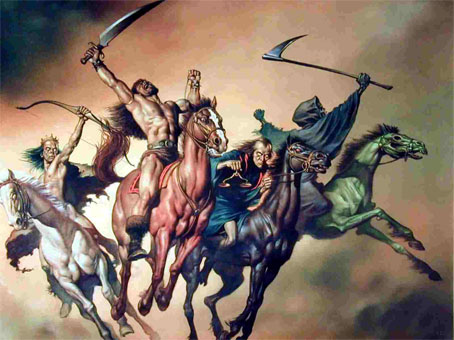
When he opened the fourth seal, I heard the voice of the fourth living creature say, “Come!” And I looked, and behold, a green [Greek: chloros] horse! And its rider’s name was Death, and Hades followed him. And they were given authority over a fourth of the [Land], to kill with sword and with famine and with pestilence and by wild beasts of the [Land].
The four horsemen of the apocalypse are the Gospel. They are released as the seals on the New Covenant scroll are broken by Christ after His ascension. The white horse brings the Word, the red horse brings division (as Jesus promised), the black horse starves the old order (or Covenant) but does no harm to the new, and finally, the green horse (a Levite with a sword1), ends the old order.
Continue reading
Comments Off | tags: Ascension, Creation Week, Dominion Theology, Four Horsemen, James Jordan, Revelation | posted in Biblical Theology, The Last Days
Apr
10
2009
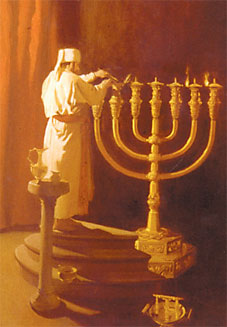 The golden Lampstand, with seven flames, pictured the sun, moon and five planets (those visible to the naked eye) that govern the firmament*—the seven “eagle-eyes” of God. In Ezekiel 1, this corresponded to the face of the Eagle that always faced north, watching over the people of God, the Table of Showbread (the face of the Man).
The golden Lampstand, with seven flames, pictured the sun, moon and five planets (those visible to the naked eye) that govern the firmament*—the seven “eagle-eyes” of God. In Ezekiel 1, this corresponded to the face of the Eagle that always faced north, watching over the people of God, the Table of Showbread (the face of the Man).
The Lampstand was also a stylised almond tree. In Hebrew, the word translated “almond” is also the word for “watcher, overseer.” An almond tree is a shepherdwho grows out of the earth and reaches heaven—a Tree of Life.
The serpent usurped Adam’s authority in the garden, and he became the legal judge (satan) of mankind, standing full of eyes before the ark/throne – seven stars at God’s right hand. As the ancients, including Solomon, sculpted wild beasts to guard their thrones, so this angelic tutor became a beast “crouching at the door.” Man had to pass him to reign with God. We see him before God’s throne in Job. He roamed to and fro on the Land like a raven and returned to accuse God’s people. The angel of light—the shepherd “Lampstand”—had become a wolf.
*The governing lights were created on Day 4. The speech concerning the Lampstand is the fourth speech regarding the Tabernacle construction.
Comments Off | tags: Creation Week, Lampstand, Satan, Typology | posted in Biblical Theology
Apr
10
2009
 or ‘How to Raise Monsters’
or ‘How to Raise Monsters’
Peter Leithart points out that the very early verses in John’s gospel can be corresponded with the Creation week:
DAY 1: The Light of the World (1:1-18)
DAY 2: The Baptism of John (1:19-28)
DAY 3: Jesus’ Baptism (1:29-34): dry land emerges from water, “the next day.”
DAY 4: John Points Disciples to Jesus (1:35-39)
DAY 5: Disciples Bring Brothers (1:40-42)
DAY 6: Jesus and Nathanael (1:43-51): “the following day,” the first day
DAY 7: [nothing]: Sabbath; the second day
DAY 8: The Wedding at Cana (2:1-11): “the third day”
More detail here.
It seems to be the case with many Bible books that they start off with a small seven, which is part of a larger one, which is then part of a great seven that structures the book (among other internal structures).
As with Matthew’s gospel, the next level in John covers the first few chapters, and might even solve a textual difficulty:
Continue reading
Comments Off | tags: Creation Week, Daniel, John, Peter Leithart, Priesthood, Typology | posted in Biblical Theology
Apr
8
2009
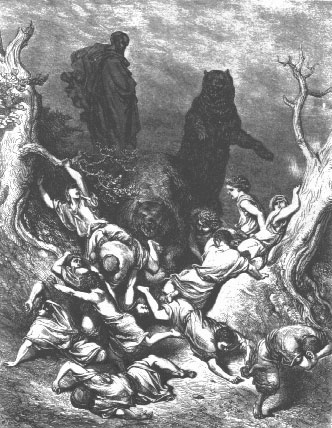
Here is a comment I posted on another blog. The blog accuses God (and the Bible) of cruelty as a basis to reject the Scriptures:
And he [Elisha] went up from thence unto Bethel: and as he was going up by the way, there came forth little children out of the city, and mocked him, and said unto him, Go up, thou bald head; go up, thou bald head. And he turned back, and looked on them, and cursed them in the name of the LORD. And there came forth two she bears out of the wood, and tare forty and two children of them. 2 Kings 2:23-24
Continue reading
Comments Off | tags: AD70, Creation Week, Elijah, Elisha, Joshua, Moses, Remnant | posted in Apologetics, Bible Matrix, Biblical Theology, The Last Days
Apr
8
2009
“God’s creation of Israel was like his creation of the world. The cosmos has an order that will someday be undone. Israel had an order that was undone. And so the un-creation of Israel is sometimes described in the analogous cosmic terms.
Jeremiah was the prophet on duty when Jerusalem fell to the Babylonians and the temple was destroyed. Israel was de-created. No more son of David on the throne. No more temple in Jerusalem. No more people in the land. Jeremiah describes this coming cataclysm in terms of cosmic creation: 4:23 “I looked upon the earth and behold it was formless and void; and to the heavens, and they had no light.”
Jeremiah is not the only prophet to talk like this. And unless we understand that this is part of the prophetic vocabulary, we will come to the book of Revelation and read about stars falling from heaven and other cosmic disasters, and we will not immediately think, “Oh, so Jerusalem and the temple are going to be destroyed and the people removed from the land again. Ah.”
(This is not a new thought here, at all. But American evangelicals have a very persistent misunderstanding in this matter.)”
Keith Ghormley, http://presbyteer.blogspot.com
Comments Off | tags: Creation Week, Eschatology, Jeremiah | posted in Biblical Theology, Quotes, The Last Days
Apr
8
2009
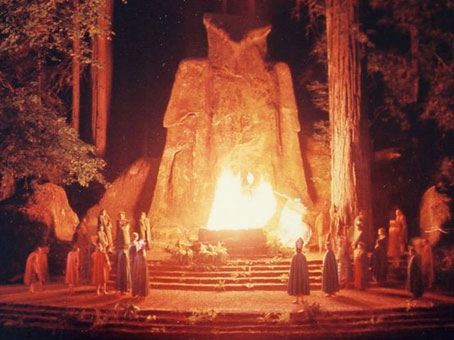 During the Creation week, there were three days of forming new “empty spaces” by dividing the original watery deep (the Abyss), then three days of filling them. A ‘world model’ develops with God’s throne at the top and the Abyss at the bottom, the place furthest from the throne. The architecture of the Tabernacle follows this model, laid out upon the ground.
During the Creation week, there were three days of forming new “empty spaces” by dividing the original watery deep (the Abyss), then three days of filling them. A ‘world model’ develops with God’s throne at the top and the Abyss at the bottom, the place furthest from the throne. The architecture of the Tabernacle follows this model, laid out upon the ground.
When the priesthood – the Land-mediators – disobeyed God, the Abyss was dredged up to cover the Land (holy place). We see this first in the flood, and later in the invasions of Assyria, Babylon and Rome.
The Valley of Hinnom became a symbol of the ‘Abyss’ below the true mountain of God. As an evil twin of the holy place, it was an ‘Adamic’ clay pit with no glorious metal. It was also the place where Judah sacrificed their infants to false gods. It was counterfeit worship in the tabernacle of hell, and the Lord said He would fill it with their bodies. Their dark ‘table of showbread’ became a snare. [Read Jeremiah 19]
After the Babylonian captivity, Zechariah saw the church in “the deep” (often translated valley or glen). A new Land-altar was rising out of the ‘waters’ – a new mountain of God, with a new Eden-temple to mediate for the world.
TAOTA
Comments Off | tags: Altar of the Abyss, Babylon, Creation Week, Exile, Gehenna, Jeremiah, Priesthood, Tabernacle, Table of Showbread, The flood, Zechariah | posted in Biblical Theology, The Restoration Era
































